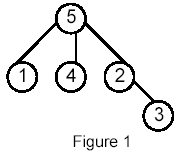POJ_1470_ClosestCommonAncestors
2015-08-10 00:25
302 查看
Closest Common Ancestors
Description
Write a program that takes as input a rooted tree and a list of pairs of vertices. For each pair (u,v) the program determines the closest common ancestor of u and v in the tree. The closest common ancestor of two nodes u and v
is the node w that is an ancestor of both u and v and has the greatest depth in the tree. A node can be its own ancestor (for example in Figure 1 the ancestors of node 2 are 2 and 5)
Input
The data set, which is read from a the std input, starts with the tree description, in the form:
nr_of_vertices
vertex:(nr_of_successors) successor1 successor2 ... successorn
...
where vertices are represented as integers from 1 to n ( n <= 900 ). The tree description is followed by a list of pairs of vertices, in the form:
nr_of_pairs
(u v) (x y) ...
The input file contents several data sets (at least one).
Note that white-spaces (tabs, spaces and line breaks) can be used freely in the input.
Output
For each common ancestor the program prints the ancestor and the number of pair for which it is an ancestor. The results are printed on the standard output on separate lines, in to the ascending order of the vertices, in the format:
ancestor:times
For example, for the following tree:

Sample Input
Sample Output
Hint
Huge input, scanf is recommended.
Source
Southeastern Europe 2000
这貌似是个著名问题
不过,目前不会正统方法
放在了树状数组和线段树的分类里,但是并不知道为什么
留下来个坑
自己就用了一种很菜的方法
反正询问是从下往上的,干脆让儿子节点找自己的父亲
这个感觉来自于并查集
另外输入输出这个题目有点坑
不过c语言可以利用自身的优势,强行查找空格等
| Time Limit: 2000MS | Memory Limit: 10000K | |
| Total Submissions: 17232 | Accepted: 5525 |
Write a program that takes as input a rooted tree and a list of pairs of vertices. For each pair (u,v) the program determines the closest common ancestor of u and v in the tree. The closest common ancestor of two nodes u and v
is the node w that is an ancestor of both u and v and has the greatest depth in the tree. A node can be its own ancestor (for example in Figure 1 the ancestors of node 2 are 2 and 5)
Input
The data set, which is read from a the std input, starts with the tree description, in the form:
nr_of_vertices
vertex:(nr_of_successors) successor1 successor2 ... successorn
...
where vertices are represented as integers from 1 to n ( n <= 900 ). The tree description is followed by a list of pairs of vertices, in the form:
nr_of_pairs
(u v) (x y) ...
The input file contents several data sets (at least one).
Note that white-spaces (tabs, spaces and line breaks) can be used freely in the input.
Output
For each common ancestor the program prints the ancestor and the number of pair for which it is an ancestor. The results are printed on the standard output on separate lines, in to the ascending order of the vertices, in the format:
ancestor:times
For example, for the following tree:

Sample Input
5 5:(3) 1 4 2 1:(0) 4:(0) 2:(1) 3 3:(0) 6 (1 5) (1 4) (4 2) (2 3) (1 3) (4 3)
Sample Output
2:1 5:5
Hint
Huge input, scanf is recommended.
Source
Southeastern Europe 2000
这貌似是个著名问题
不过,目前不会正统方法
放在了树状数组和线段树的分类里,但是并不知道为什么
留下来个坑
自己就用了一种很菜的方法
反正询问是从下往上的,干脆让儿子节点找自己的父亲
这个感觉来自于并查集
另外输入输出这个题目有点坑
不过c语言可以利用自身的优势,强行查找空格等
#include <iostream>
#include <stdio.h>
#include <string.h>
using namespace std;
const int M=905;
int tree[M];
int isp[M];
int num[M];
void sett()
{
for(int i=1;i<M;i++)
tree[i]=i;
}
int find(int a,int b)
{
memset(isp,0,sizeof(isp));
while(tree[a]!=a)
{
isp[a]=1;
a=tree[a];
}
isp[a]=1;
while(!isp[b])
b=tree[b];
return b;
}
int main()
{
int v;
int f,sn,s;
int qn,qa,qb;
//freopen("1.in","r",stdin);
//freopen("2.out","w",stdout);
while(scanf("%d",&v)!=EOF)
{
memset(num,0,sizeof(num));
sett();
for(int i=0;i<v;i++)
{
scanf("%d %*c%*c %d %*c",&f,&sn);
//cout<<"11 "<<f<<" "<<sn<<endl;
for(int j=0;j<sn;j++)
{
scanf("%d",&s);
tree[s]=f; //生成从下往上的伪树,有点像并查集
}
}
//cout<<"1";
scanf("%d",&qn);
for(int i=0;i<qn;i++)
{
scanf(" %*c%d%d %*c",&qa,&qb);
//cout<<qa<<" "<<qb<<endl;
num[find(qa,qb)]++;
}
for(int i=1;i<=v;i++)
{
if(num[i])
printf("%d:%d\n",i,num[i]);
}
}
return 0;
}
相关文章推荐
- HDOJ1698 Just a Hook(线段树)
- 如何在防火墙或路由器中禁止访问一些公司不相关网站
- 读写锁
- Codeforces Round #130 (Div. 2) A. Dubstep(STL做法)
- springMVC MultipartFile file文件上传及参数接受
- Microsoft Dynamics CRM server 2013 系统和SQL server 备份 为升级 CRM 2015版本准备
- Microsoft Dynamics CRM server 2013 系统和SQL server 备份 为升级 CRM 2015版本准备
- delphi之模拟点击网页中的按钮
- 算法题:求二进制位中0的个数
- 命名管道客户端及服务器端简单代码示例
- HDOJ1394 Minimum Inversion Number(线段树)
- UI019---ITableviewcell的性能问题和缓存优化
- POJ_2352_Stars
- CentOS增加swap分区
- 使用Xcode实现第一个C语言程序——Hello world
- PBOC交易过程详解
- UI018---UITableView使用
- UVALive - 4329 Ping pong (树状数组)
- intellij idea 修改背景保护色&&修改字体&&快捷键大全
- Windows/Linux远程桌面
